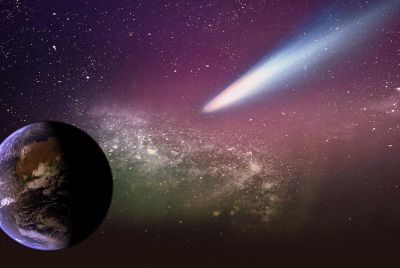Avi Loeb Claims 3I/ATLAS May Be Made of Antimatter—'The Most Efficient Fuel'

The mystery surrounding interstellar comet 3I/ATLAS has deepened after Harvard astrophysicist Avi Loeb suggested it could be made of antimatter, a substance that annihilates normal matter and releases near-total energy.
Writing on Medium, Loeb called antimatter 'the most efficient fuel' in the universe, arguing that if 3I/ATLAS truly contained it, its passage through the ambient zodiacal dust might generate detectable gamma-ray or X-ray emissions—signals that NASA's Fermi Gamma-Ray Space Telescope or the Chandra X-ray observatory could observe. Though he stressed the theory was 'pedagogical,' the claim has reignited debate over whether this cosmic visitor might be more than just another comet.
Loeb noted that while antimatter is the 'most efficient fuel,' manufacturing it at scale would imply a 'technological' origin, as it is incredibly rare and expensive to produce.
There is a possibility that #3IATLAS is made of antimatter said Avi Loeb
— Surajit (@surajit_ghosh2) November 2, 2025
He explained that antimatter is an excellent fuel because when it interacts with matter it converts the entire mass into energy (E=mc²) making it the most efficient fuel known pic.twitter.com/0Y7iXSBUrt
A Rare and Puzzling Interstellar Visitor
The comet-like object 3I/ATLAS, officially designated C/2025 N1, was discovered on 1 July by the Asteroid Terrestrial-impact Last Alert System (ATLAS) in Hawaii.
According to EarthSky, it is only the third confirmed interstellar visitor to enter the Solar System, following ʻOumuamua in 2017 and 2I/Borisov in 2019.
According to Sky & Telescope, the orbit of 3I/ATLAS is inclined 175° to the ecliptic, which places it within about 5° of the plane of the Solar System's planets.
Based on a 'detailed analysis of the Hubble Space Telescope image,' Loeb notes that the dust around the object is not opaque, meaning its brightness must come from the nucleus itself. Observations showed that the object exhibited 'reddening' and had a 'red surface,' which Loeb interpreted as possible evidence of internal energy generation rather than mere reflection of sunlight.
The Harvard astrophysicist pointed out that 3I/ATLAS had a high luminosity (10 gigawatts) that implied a radius of about 10 kilometers. He argues this large size, potentially 'a million times more massive' than previous interstellar objects, is the central puzzle, suggesting the presence of an additional energy source.
In an interview cited by Newsweek, Loeb said this unexpectedly high brightness 'could indicate... an energy source other than sunlight,' although he stopped short of declaring it evidence of alien design.
Why Loeb Believes Antimatter Fits the Data
In his Medium essay, Loeb reasoned that if 3I/ATLAS consisted of antimatter, annihilation with ambient zodiacal dust could produce its unusual glow. He calculated this annihilation would produce a 'gamma-ray luminosity of a few gigawatts, coincidentally comparable to the power emitted by 3I/ATLAS in visible light.'
'The mix of matter and antimatter offers the most efficient fuel,' he wrote, emphasising that 'complete mass-to-energy conversion is unmatched by any chemical or nuclear reaction.'
He also acknowledged that such material is costly and unstable.
'On Earth, producing one gram of antimatter would cost about five quadrillion dollars,' Loeb calculated, underscoring the sheer rarity of the substance.
Although the notion borders on science fiction, Loeb said it was 'testable' through future observations, particularly by monitoring for high-energy emissions or unusual spectral signatures as the object continues its journey through the inner Solar System using the Fermi Gamma-Ray Space Telescope or the Chandra X-ray observatory.
Mainstream Science Pushes Back
Mainstream scientists have responded with scepticism. Dr Samantha Lawler, an astrophysicist at the University of Regina in Canada, told EarthSky that 'extraordinary claims require extraordinary evidence, and the evidence presented is absolutely not extraordinary.'
NASA, in comments reported by The Guardian, said 3I/ATLAS 'behaves like a natural comet in all observable ways' and that no credible data indicate artificial or exotic composition.
Astronomers also note that non-gravitational accelerations are common among comets when sunlight heats their surfaces and drives gas jets that push them slightly off course.
Moreover, cosmologists argue that significant concentrations of antimatter in the universe are ruled out by gamma-ray observations, according to findings published on arXiv.
Even Loeb conceded that large antimatter bodies should have been destroyed soon after the Big Bang.
A Debate That Keeps Astronomers Watching
Despite the doubts, scientists agree that 3I/ATLAS is worth continued observation. Teams around the world plan to track its brightness, tail development and trajectory to determine whether the anomalies (of high brightness and large size) Loeb cites persist or can be explained by more conventional physics, according to Newsweek.
In a separate post titled Should We Be Happier if 3I/ATLAS Is a Comet?, Loeb wrote that even if the object turns out to be entirely natural, 'we should still celebrate, because nature continues to surprise us without needing aliens or antimatter.'
As 3I/ATLAS speeds away from the Sun, the debate it sparked underscores how little is known about the interstellar material passing through our cosmic neighbourhood--and how far astronomers are willing to stretch imagination in search of answers.
© Copyright IBTimes 2025. All rights reserved.





















